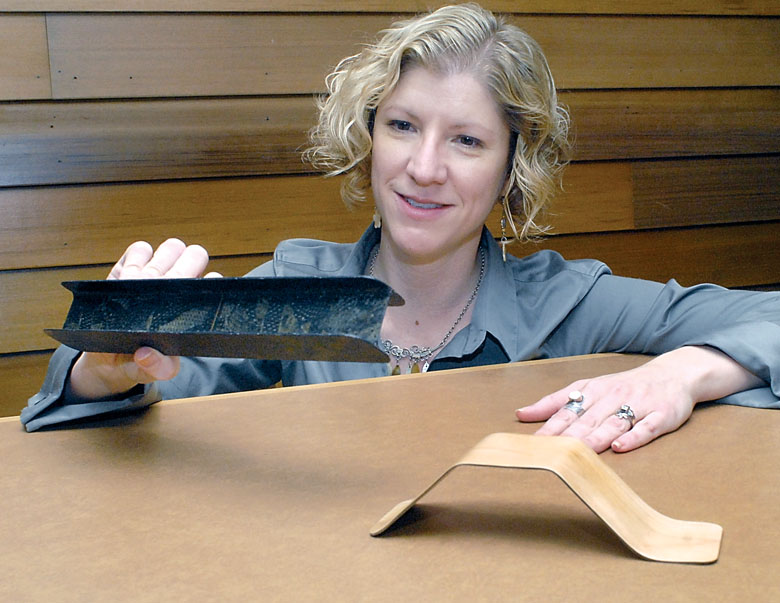PORT ANGELES — “Little they are,” Yoda might say. But like him, they’re lightweight and strong.
Call them doodads or doohickeys if you will, but they’re literally the stuff of which Clallam County’s newest industry may build its future.
They’re made from recycled carbon-fiber composite scraps that were cast off by the aerospace industry.
The ribbon-like thingamajig is laminated on both sides with genuine maple veneer.
A second item, a miniature I-beam, has a design hinting at structural applications.
Both were designed and manufactured by students in the Peninsula College Advanced Materials-Composites program.
The college hopes to relocate its labs and classrooms to the $5.3 million Composite Materials Technology Center by the fall term.
Other schools that include Washington State University, the University of Washington, and the University of Alabama are research partners in the CRTC, which its director hopes to open in July at 2020 W. 19th St. at Fairchild International Airport.
Bob Larsen, chairman of the nonprofit CRTC board, last week told Port of Port Angeles commissioners about the center’s progress.
Officials led by Gov. Jay Inslee — who wielded a recycled carbon-fiber shovel — broke ground in September inside the 25,000-square-foot shell after the CRTC received $3.5 million in county, state and federal grants.
The port has committed $1.5 million to the project. The CRTC, a nonprofit corporation, will legally be a port tenant, not a subsidiary.
The directors — who include members associated with Washington State University and Pacific Northwest National Laboratory — hope to equip it with recycling and manufacturing machinery using another $1.35 million from the state’s Clean Energy Fund.
Approval or denial of the grant could come next month.
In its first 14 weeks as an independent corporation — albeit one created and supported by the port — the center has received a letter of intent from an end-product carbon-fiber company to open a plant in Port Angeles.
“We already have people raising their hands and saying, ‘We want to join you,’ ” Larsen said, declining to name the company “at this moment” but adding, “Stay tuned.”
The CRTC plans to receive scrap carbon-fiber from Puget Sound-area aerospace firms in refrigerated trucks and store the mildly volatile material in freezers until it processes the material; refrigerating it, said officials, prevents it from deteriorating due to heat.
The center estimates a maximum of six semi-trailer trucks a month would make the trip.
The trimmings are worth up to $60 per pound, according to the port’s composites consultant, Geoff Wood.
Washington state produces 1.4 million pounds of composite scrap each year, but manufacturers like the Boeing Co. cannot use recycled materials in aerospace configurations. However, it is used in products ranging from solar panels frames to ski poles, computer cases to snowboards.
The CRTC will continue to receive $615,000 in marketing support from the port, he said, but predicted it will be self-sustaining by 2018.
By then, it will research and develop new uses for scrap carbon-fiber material. It’s a laminated product that in its virgin state is used in the outer shell of Boeing’s 787 Dreamliner and BMW’s i3 electric car.
“We have already been contacted by more than a dozen companies,” Larsen said about potential R&D partners, “so we know they’re out there.”
As he showed commissioners a sample ribbon-like strip of maple/carbon-fiber laminate, Larsen asked, “Can you imagine a whole line of furniture that combines the wood that we’re so famous for with carbon fiber?”
Peninsula College will apply for a patent on the wood/composite laminate by the end of this year, he said.
Next year’s goals include assembling a management team. In 2017, the CRTC wants to open an Innovation Center “to attract artisans, futurists, people who have these great ideas, and let ’em go,” Larsen said.
He said directors also want to establish an engineer-in-residence program for its business partners.
“We want to make the CRTC a destination for top designers.”
By 2019, the CRTC hopes to become the supplier of recycled carbon-fiber to a number of manufacturers in Clallam County. By 2020, Larsen said the center could divert 250,000 pounds of carbon-fiber composites a year away from landfills.
At that time, the center could start producing larger products and to expand into the building at 1010 W. 18th St. A year ago, the port upgraded heating, ventilation and air-conditioning equipment there.
Eventually, a consultant forecasts that 340 people will hold jobs at the center and its associated firms.
“People will be coming to Port Angeles to get material that will be the feedstock for their new products,” he said.
“There is a line of partners waiting to engage with us when we get up and running.
“This is not pie in the sky.”
_______
Reporter James Casey can be reached at 360-452-2345, ext. 5074, or at jcasey@peninsuladailynews.com.

